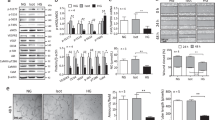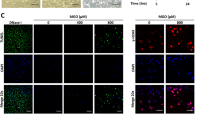Abstract
Diabetic patients frequently suffer from retinopathy, nephropathy, neuropathy and accelerated atherosclerosis. The loss of endothelial function precedes these vascular alterations. Here we report that activation of poly(ADP-ribose) polymerase (PARP) is an important factor in the pathogenesis of endothelial dysfunction in diabetes. Destruction of islet cells with streptozotocin in mice induced hyperglycemia, intravascular oxidant production, DNA strand breakage, PARP activation and a selective loss of endothelium-dependent vasodilation. Treatment with a novel potent PARP inhibitor, starting after the time of islet destruction, maintained normal vascular responsiveness, despite the persistence of severe hyperglycemia. Endothelial cells incubated in high glucose exhibited production of reactive nitrogen and oxygen species, consequent single-strand DNA breakage, PARP activation and associated metabolic and functional impairment. Basal and high-glucose-induced nuclear factor-κB activation were suppressed in the PARP-deficient cells. Our results indicate that PARP may be a novel drug target for the therapy of diabetic endothelial dysfunction.
This is a preview of subscription content, access via your institution
Access options
Subscribe to this journal
Receive 12 print issues and online access
$209.00 per year
only $17.42 per issue
Buy this article
- Purchase on Springer Link
- Instant access to full article PDF
Prices may be subject to local taxes which are calculated during checkout






Similar content being viewed by others
References
Pieper, A.A., Verma, A., Zhang, J. & Snyder, S.H. Poly (ADP-ribose) polymerase, NO and cell death. Trends Pharmacol. Sci. 20, 171–181 (1999).
Cell Death: The Role of PARP (ed. Szabó, C.) (CRC Press, Boca Raton, Florida, 2000).
Eliasson, M.J. et al. Poly(ADP-ribose) polymerase gene disruption renders mice resistant to cerebral ischemia. Nature Med. 3, 1089–1095 (1997).
Zingarelli, B., Salzman, A.L. & Szabó, C. Genetic disruption of poly (ADP-ribose) synthetase inhibits the expression of P-selectin and intercellular adhesion molecule-1 in myocardial ischemia/reperfusion injury. Circ. Res. 83, 85–94 (1998).
Burkart, V. et al. Mice lacking the poly(ADP-ribose) polymerase gene are resistant to pancreatic β-cell destruction and diabetes development induced by streptozocin. Nature Med. 5, 314–319 (1999).
Pieper, A.A. et al. Poly(ADP-ribose) polymerase-deficient mice are protected from streptozotocin-induced diabetes. Proc. Natl. Acad. Sci. USA 96, 3059–3064 (1997).
Szabó, C., Cuzzocrea, S., Zingarelli, B., O'Connor, M. & Salzman, A.L. Endothelial dysfunction in a rat model of endotoxic shock. Importance of the activation of poly (ADP-ribose) synthetase by peroxynitrite. J. Clin. Invest. 100, 723–735 (1997).
Oliver, F.J. et al. Resistance to endotoxic shock as a consequence of defective NF-κB activation in poly (ADP-ribose) polymerase-1 deficient mice. EMBO J. 18, 4446–4454 (1999).
Tooke, J.E. & Goh, K.L. Vascular function in Type 2 diabetes mellitus and pre-diabetes: the case for intrinsic endotheiopathy. Diabet. Med. 16, 710–715 (1999).
Keen, H., Clark, C. & Laakso, M. Reducing the burden of diabetes: managing cardiovascular disease. Diabetes Metab. Res. Rev. 15, 186–196 (1999).
Rodriguez-Manas, L. et al. Endothelial dysfunction and metabolic control in streptozotocin-induced diabetic rats. Br. J. Pharmacol. 123, 1495–1502 (1998).
Graier, W.F., Posch, K., Fleischhacker, E., Wascher, T.C. & Kostner, G.M. Increased superoxide anion formation in endothelial cells during hyperglycemia: an adaptive response or initial step of vascular dysfunction? Diabetes Res. Clin. Pract. 45, 153–160 (1999).
Nishikawa, T. et al. Normalizing mitochondrial superoxide production blocks three pathways of hyperglycaemic damage. Nature 404, 787–790 (2000).
Ischiropoulos, H. et al. Peroxynitrite-mediated tyrosine nitration catalyzed by superoxide dismutase. Arch. Biochem. Biophys. 298, 431–437 (1992).
Halliwell, B. What nitrates tyrosine? Is nitrotyrosine specific as a biomarker of peroxynitrite formation in vivo? FEBS Lett. 411, 157–160 (1997).
Furchgott, R.F. Studies on endothelium-dependent vasodilation and the endothelium-derived relaxing factor. Acta Physiol. Scand. 139, 257–270 (1990).
Pieper, G.M., Jordan, M., Adams, M.B. & Roza, A. Syngeneic pancreatic islet transplantation reverses endothelial dysfunction in experimental diabetes. Diabetes 44, 1106–1113 (1995).
Kobayashi, T. & Kamata, K. Effect of insulin treatment on smooth muscle contractility and endothelium-dependent relaxation in rat aortae from established STZ-induced diabetes. Br. J. Pharmacol. 127, 835–842 (1999).
Smith, S., Giriat, I., Schmitt, A. & de Lange, T. Tankyrase, a poly(ADP-ribose) polymerase at human telomeres. Science 282, 1484–1487 (1998).
Sallmann, F.R., Vodenicharov, M.D., Wang, Z.Q. & Poirier, G.G. Characterization of sPARP-1. J. Biol. Chem. 275, 15504–15511 (2000).
Szabó, C., Zingarelli, B., O'Connor, M. & Salzman, A.L. DNA strand breakage, activation of poly (ADP-ribose) synthetase, and cellular energy depletion are involved in the cytotoxicity of macrophages and smooth muscle cells exposed to peroxynitrite. Proc. Natl. Acad. Sci. USA 93, 1753–1758 (1996).
Pieper, G.M., Langenstroer, P. & Siebeneich, W. Diabetic-induced endothelial dysfunction in rat aorta: role of hydroxyl radicals. Cardiovasc. Res. 34, 145–156 (1997).
Du, X., Stocklauser-Farber, K. & Rosen, P. Generation of reactive oxygen intermediates, activation of NF-κB, and induction of apoptosis in human endothelial cells by glucose: role of NO synthase? Free Radic. Biol. Med. 27, 752–763 (1999).
Karasu, C. Time course of changes in endothelium-dependent and -independent relaxation of chronically diabetic aorta: role of reactive oxygen species. Eur. J. Pharmacol. 392, 163–173 (2000).
Pieper, G.M., Moore-Hilton, G. & Roza, A.M. Evaluation of the mechanism of endothelial dysfunction in the genetically-diabetic BB rat. Life Sci. 58, PL147–512 (1996).
Cosentino, F., Hishikawa, K., Katusic, Z.S. & Luscher, T.F. High glucose increases NO synthase expression and superoxide anion generation in human aortic endothelial cells. Circulation 96, 25–28 (1997).
Nishigaki, R. et al. Ultrastructural changes and immunohistochemical localization of nitric oxide synthase, advanced glycation end products and NF-κB in aorta of streptozotocin treated Mongolian gerbils. Nippon Ika Daigaku Zasshi 66, 166–175 (1999).
Eiserich, J.P. et al. Formation of nitric oxide-derived inflammatory oxidants by myeloperoxidase in neutrophils. Nature 391, 393–397 (1998).
Szabó, C. et al. Protection against peroxynitrite-induced fibroblast injury and arthritis development by inhibition of poly(ADP-ribose) synthase. Proc. Natl. Acad. Sci. USA 95, 3867–3872 (1998).
Pieper, G.M. & Riaz-ul-Haq, G. Activation of nuclear factor-κB in cultured endothelial cells by increased glucose concentration: prevention by calphostin C. J. Cardiovasc. Pharmacol. 30, 528–532 (1997).
Morigi, M. et al. Leukocyte-endothelial interaction is augmented by high glucose concentrations and hyperglycemia in a NF-κB-dependent fashion. J. Clin. Invest. 101, 1905–1915 (1998).
Barouch, F.C. et al. Integrin-mediated neutrophil adhesion and retinal leukostasis in diabetes. Invest. Ophthalmol. Vis. Sci 41, 1153–1158 (2000).
Wang, Z.Q. et al. Mice lacking ADPRT and poly(ADP-ribosyl)ation develop normally but are susceptible to skin disease. Genes Dev. 9, 509–520 (1995).
Kaufmann, S.H., Mesner, P.W. Jr., Samejima, K., Tone, S. & Earnshaw, W.C. Detection of DNA cleavage in apoptotic cells. Methods Enzymol. 322, 3–15 (2000).
Shen, H. & Ong, C. Detection of oxidative DNA damage in human sperm and its association with sperm function and male infertility. Free Radic. Biol. Med. 28, 529–536 (2000).
Didier, M. et al. DNA strand breaks induced by sustained glutamate excitotoxicity in primary neuronal cultures. J. Neurosci. 16, 2238–2250 (1996).
Zhang, J. Use of biotinylated NAD to label and purify ADP-ribosylated proteins. Methods Enzymol. 280, 255–265 (1997).
Scott, G.S., Jakeman, L.B., Stokes, B.T. & Szabó, C. Peroxynitrite production and activation of poly (adenosine diphosphate-ribose) synthetase in spinal cord injury. Ann. Neurol. 45, 120–124 (1999).
Gerritsen, M.E. et al. Activation-dependent isolation and culture of murine pulmonary microvascular endothelium. Microcirculation 2, 151–163 (1995).
Klaidman L.K., Leung, A.C. & Adams, J.C. Jr. High-performance liquid chromatography analysis of oxidized and reduced pyridine dinucleotides in specific brain regions. Anal. Biochem. 228, 312–317 (1995).
Lamas S., Michel, T., Brenner, B.M, Marsden, P.A. Nitric oxide synthesis in endothelial cells: evidence for a pathway inducible by TNF-α. Am. J. Physiol. 261, C634–641 (1991).
Lantin-Hermoso, R.L. et al. Estrogen acutely stimulates nitric oxide synthase activity in fetal pulmonary artery endothelium. Am. J. Physiol. 273, L119–126 (1997).
Gilad, E. et al. Melatonin inhibits expression of the inducible isoform of nitric oxide synthase in murine macrophages: role of inhibition of NF-κB activation. FASEB J. 12, 685–693 (1998).
Banasik, M., Komura, H., Shimoyama, M. & Ueda, K. Specific inhibitors of poly(ADP-ribose) synthetase and mono(ADP-ribosyl)transferase. J. Biol. Chem. 267, 1569–1575 (1992).
Virag, L. et al. Requirement of intracellular calcium mobilization for peroxynitrite-induced poly(ADP-ribose) synthetase activation and cytotoxicity. Mol. Pharmacol. 56, 824–833 (1999).
Acknowledgements
This work was supported by grants from the National Institutes of Health to C.S. (R01GM60915 and R21HL65145). F.G.S. was supported by a fellowship from FAPESP (Brazil). L.V. was supported by a Bolyai Fellowship of the hungarian Academy of Sciences and L.L. was supported by the ADUMED Foundation (Switzerland).
Author information
Authors and Affiliations
Corresponding author
Rights and permissions
About this article
Cite this article
Garcia Soriano, F., Virág, L., Jagtap, P. et al. Diabetic endothelial dysfunction: the role of poly(ADP-ribose) polymerase activation. Nat Med 7, 108–113 (2001). https://doi.org/10.1038/83241
Received:
Accepted:
Issue Date:
DOI: https://doi.org/10.1038/83241
This article is cited by
-
Targeting protein modifications in metabolic diseases: molecular mechanisms and targeted therapies
Signal Transduction and Targeted Therapy (2023)
-
PARP1 mediated PARylation contributes to myogenic progression and glucocorticoid transcriptional response
Cell Death Discovery (2023)
-
Endothelial LRP1-ICD Accelerates Cognition-Associated Alpha-Synuclein Pathology and Neurodegeneration through PARP1 Activation in a Mouse Model of Parkinson’s Disease
Molecular Neurobiology (2023)
-
Role of poly(ADP-ribose) polymerase-1 in regulating human islet cell differentiation
Scientific Reports (2022)
-
Cytoprotective Effect of Biogenic Magnesium Hydroxide Nanoparticles Using Monodora myristica Aqueous Extract Against Oxidative Damage in Streptozotocin-Induced Diabetic Rats
BioNanoScience (2022)



